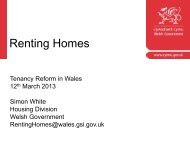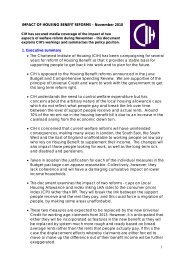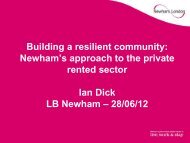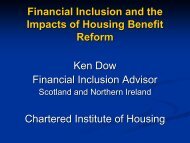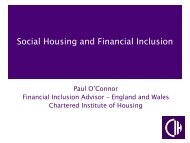View publication - Chartered Institute of Housing
View publication - Chartered Institute of Housing
View publication - Chartered Institute of Housing
You also want an ePaper? Increase the reach of your titles
YUMPU automatically turns print PDFs into web optimized ePapers that Google loves.
PART TWO: LEADING TOMORROW<br />
How Fabrick are gearing up to deliver on the sustainable<br />
neighbourhoods agenda over the next 5-10 years<br />
By Allison Joynes, Organisation Development Manager, Fabrick Group<br />
Summary<br />
The housing industry is facing unprecedented change. Aligned with an<br />
economic climate <strong>of</strong> continued uncertainty and the withdrawing <strong>of</strong> many key<br />
services at a local level, it is perhaps understandable that some <strong>of</strong> our peers<br />
are retrenching their positions and refocusing their activities on core housing<br />
activities at a time when the needs <strong>of</strong> our customers are increasing. Fabrick,<br />
however, have taken a different view. We have acknowledged that there are a<br />
number <strong>of</strong> external factors that will directly impact upon our ability to deliver<br />
services at a level <strong>of</strong> quality that our residents deserve. We have taken account<br />
<strong>of</strong> that within our business plans, but, we have also recognised that there are<br />
many ways in which we can work in partnership with agencies in our<br />
neighbourhoods to ensure that we are making the best use <strong>of</strong> assets and the<br />
best use <strong>of</strong> the resources that are available. This can best be described as our<br />
approach to financial viability whilst also demonstrating the need to evidence<br />
social value outcomes and supporting sustainable neighbourhoods.<br />
Preparing for change<br />
As we prepared for the potential impact <strong>of</strong> welfare reform, knowing we had a good<br />
relationship with our local authority partners who were also about to lose resources, we<br />
took an honest look at how we delivered services to our neighbourhoods and the<br />
difference we were actually making. The structure, that had stood us in good stead as a<br />
social housing provider, was formed around housing management. We had housing<br />
managers supported by housing <strong>of</strong>ficers supported by administration staff. As such, and<br />
by default, the service had become process driven, acting reactively rather than<br />
proactively to demands placed upon it by customers. In fact, a systems thinking project<br />
confirmed that we were managing by exception and therefore only really providing a<br />
service to 20 per cent <strong>of</strong> our customers – those who either came to us, or whom we<br />
visited as a result <strong>of</strong> an tenancy issue (not paying rent and/ or housing benefit not in<br />
place, anti-social behaviour etc.) Proactive steps had to be taken to ensure that our<br />
structure was configured so the main focus <strong>of</strong> all staff working within neighbourhoods<br />
134



